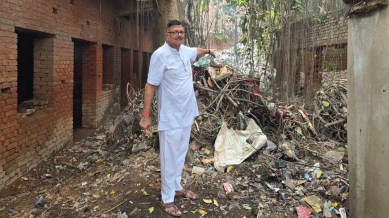Stay updated with the latest - Click here to follow us on Instagram
Sealed after Indira killing, gates to Varanasi premises with temple, gurdwara reopened
Over 40 years ago, this plot of land was locked up by the district administration to “prevent escalation” after Prime Minister Indira Gandhi on October 31, 1984, was shot dead by two of her Sikh bodyguards.

On Wednesday morning, social worker Pradeep Narayan Singh stepped inside a plot of land in Jagat Ganj, an area located in the heart of Varanasi, that was overrun with thick vegetation and crumbling structures.
On Monday, July 21 this year, the rusted locks on the orange gates to this 4,000-square-foot plot were finally broken in the presence of the members of the Shri Bade Hanuman Mandir Management Committee and the Varanasi Gurdwara Management Committee.
Dileep Kumar Mishra, Station House Officer, Chetganj Police Station, confirmed that the main gate of the disputed site was opened on Monday.
As the visibly elated members of the two committees exchanged garlands and sweets soon after the locks were broken on Monday, thanks to Singh’s mediation efforts for over two months, they also announced the “amicable” resolution of the 42-year-old dispute.
Speaking to The Indian Express over telephone, Singh says, “Around the time this complex was locked up by the district administration, the gurdwara was just a small structure and the temple was a makeshift structure. Then, Mrs Gandhi was assassinated. Since a gurdwara and a temple stood on the same plot of land, to prevent any untoward incident, the district administration decided to seal the site.”
As time passed, he added, a dispute broke out between the members of the Sikh and Hindu communities in Varanasi over possession of that land. Since then, the matter has been pending in a local court.
Though attempts were made to resolve the issue over the years, they always fell through for one reason or another, said Singh.
Sources added that makeshift structures would crop up along the disputed site’s boundary from time to time, leading to the breakdown of ongoing mediation efforts.
Then, around two months ago, the two committees approached Singh once again to help them resolve the issue.
“After several rounds of discussions, both parties agreed to submit a settlement letter in court. As part of this mutual understanding, the land has been divided equally between the two committees,” Singh says.
Calling the resolution to the 42-year-old dispute “important”, Paramjeet Singh Ahluwalia, vice-president, Gurdwara Management Committee, Varanasi, says, “After both committees agreed to resolve the dispute amicably, we approached the court concerned for a settlement. Then, we went to senior district officials. After a thorough verification process, the site was finally reopened.”
Devendra Kumar, Additional City Magistrate, Varanasi, whose court has been hearing the matter, confirmed the submission of a settlement letter by the two committees on the resolution of the dispute.
On the historical and spiritual significance this gurdwara holds for the Sikh community, Ahluwalia says, “This gurdwara is nearly 300 years old. It is revered by the community because Guru Tegh Bahadur (the ninth of 10 Sikh gurus) once set foot here.”
According to Ahluwalia, nearly 25,000 Sikhs reside in Varanasi at present. With the Jagat Ganj gurdwara, the number of gurdwaras in the district now stands at five.
“This settlement will be remembered for generations,” says Satya Narayan Pandey, the brother of mandir committee administrator and representative Shyam Narayan Pandey, who was present during the settlement meetings and the site reopening.
Ahluwalia said the construction of a gurudwara at the site is expected to begin soon. Given its significance for the community, he says he expects Sikh devotees from around the world to offer prayers at this gurdwara.
According to Pandey, the temple committee too plans to start the construction of a temple at the site soon.